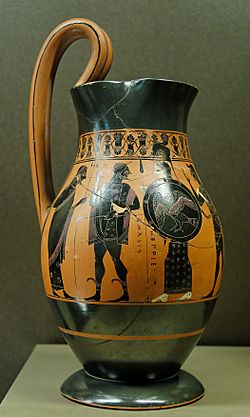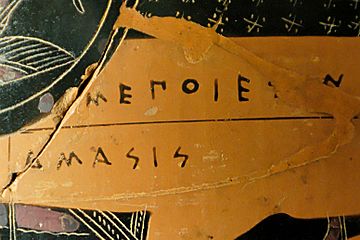Amasis Painter facts for kids
Quick facts for kids
Amasis Painter
|
|
|---|---|

Heracles entering Mount Olympus, olpe by the Amasis Painter, dated to within 550–530 BC. Inscription: AMASIS MEΠOIESEN, Amasis m'epoiesen, "Amasis made (me)". Located in the Louvre Museum, Paris.
|
|
| Born |
Amasis
Before 550 BC Athens or Egypt
|
| Died | About 510 BC |
| Nationality | Greek or Egyptian |
| Known for | Vase painting |
|
Notable work
|
About 90 vase paintings |
| Movement | Black-figure style |
| Patron(s) | Possibly Solon, if he was from Egypt |

The Amasis Painter was a famous ancient Greek artist. He painted vases in Athens between about 550 and 510 BC. He used a special style called black-figure technique. We call him the Amasis Painter because a potter named Amasis signed many of the vases he painted. The signature said "Amasis made me." Experts have found about 132 vases that this artist painted.
Contents
Life of the Amasis Painter
We don't know much about the Amasis Painter's life. This is common for artists from ancient times. His name, Amasis, is a Greek version of an Egyptian name. Some people think he might have been from Egypt. He could also have been an Athenian with an Egyptian name. This was possible because Greece and Egypt traded a lot. Another idea is that "Amasis" was a nickname.
Most experts agree that the Amasis Painter learned his skills in Athens. He probably learned from the Heidelberg Painter. This earlier painter worked around 575–550 BC. The Amasis Painter copied some scenes from the Heidelberg Painter. But he always added his own special touch. He made his figures more detailed. He also added a unique double-band border to his designs.
The Amasis Painter had a very long career. It lasted almost 50 years, from about 560 to 515 BC. During this time, vase painting changed a lot. His style was mostly traditional, but it also grew with new ideas. He kept his own consistent style, which makes it hard to know exactly when he painted each vase. His work shows how he became a master artist over time.
What the Amasis Painter Created
There are 11 black-figure vases and one broken piece that have the signature "Amasis made me." This means the potter Amasis made these items. Because one painter decorated all 12 pieces, some people thought the potter and the painter were the same person. But later, experts found a vase signed by Amasis that was painted by a different artist. So, we know that the potter Amasis and the Amasis Painter were likely two different people.
The Amasis Painter decorated many different types of vases. These included:
- Amphorae: Large jars for storing wine or oil.
- Oinochoai: Jugs for pouring wine.
- Lekythoi: Jars for oil.
- Alabastra and Aryballoi: Small bottles for oils or perfumes.
- Drinking cups: Like mastoids, skyphoi, and kylikes.
The Amasis Painter seemed to like smaller vases. Most of his works are about 30 to 35 centimeters tall. He also liked to paint in smaller areas, like panels on the vases.
What He Painted
The Amasis Painter painted almost every subject popular in his time. Out of 165 scenes, 20 show stories from Greek myths. But his most important work shows gods and people in everyday life. He also painted many scenes of daily activities.
He was one of the first artists to show gods interacting in general scenes. He painted Dionysus, the god of wine, and his followers more than 20 times. He also often painted Athena facing Poseidon. While this reminds us of their contest for Athens, his paintings usually don't tell a specific story. He also showed gods interacting with regular people. This reminds us that ancient Greeks believed gods were always present in their lives.
The Amasis Painter was also a pioneer in showing scenes from everyday life. For example, he painted a newly married couple riding in a cart. He also showed women working with wool. These scenes give us a glimpse into ancient Greek daily life.
His Artistic Style
You can recognize the Amasis Painter's style by his love for balance and clear details. He was very good at making his art expressive. He was especially skilled at painting small details. He also made sure the vase's shape and its decoration worked together perfectly.
One special thing about his style is how he sometimes used a shiny outline for women's figures. He was not the first to do this. But he was the first to mix this shiny outline with the black-figure style on one vase. This might have been a hint of the red-figure style that came later. His later work has more flowing lines and bright designs. This might show that he was influenced by the new red-figure technique.
Special Decorations
Experts can also spot the Amasis Painter's work by his unique decorations. He often used double or triple lines to frame his paintings. He also used these lines to separate the main scene from the decorative bands. He sometimes used a meander pattern. Other common designs were zig-zag bands and rosettes.
His most famous decorations are his floral bands. These designs are very lively and colorful. He started with simple upright flower buds. Later, he created a more complex design called the palmette-lotus festoon. He used these flower designs throughout his career. In his later works, they are known for being very balanced and symmetrical. Every part of the design is carefully placed.
Amasis Painter and Exekias
The Amasis Painter and Exekias were two of the most important black-figure painters. They helped the black-figure technique become fully developed. Both artists were amazing at drawing and adding details. They used these skills to make their scenes vivid and lively. For a long time, experts thought Exekias was the better artist. He was known for telling stories in his paintings. He could show moments that hinted at past and future events.
The Amasis Painter, on the other hand, was known for creating new scenes of everyday life. His best works often showed humor and cleverness. Before a big art show in 1985, the Amasis Painter was seen as less important than Exekias. But the exhibition, "The Amasis Painter and His World," changed this view. It showed that the Amasis Painter was a very important artist in ancient Greece. Both artists were very talented, each in their own way. They were both key to the development of black-figure vase painting in Athens.
"The Amasis Painter and His World" Exhibition
In 1985, a special art show called "The Amasis Painter and His World" opened. It was at the Metropolitan Museum of Art in New York. This was the first time an ancient black-figure artist had a show just for their work. The show brought together 65 works by the Amasis Painter from all over the world.
This exhibition helped people appreciate the Amasis Painter's work more. It also showed how important it was to study artists individually. Seeing so many of his works together helped people understand his style better. It also showed how his workshop fit into the larger world of vase painting in the 6th century BC. The Amasis Painter's art gives us a fascinating look into the crafts of ancient Greece.
Selected works
- Athens, Acropolis Museum
-
- Pinax 2510
- Berlin, Antikensammlung
-
- Bauchamphora F 1688
- Amphora F 1691
- Fragment einer Bauchamphora F 1692
- Bloomington, Indiana University Art Museum
-
- Amphora 71.82
- Boston, Museum of Arts
-
- Halsamphora 18026
- Amphora 01.8026
- Amphora 01.8027
- Kylix 10.651
- London, The British Museum
-
- Olpe B 52
- Olpe B 471
- Los Angeles, J. Paul Getty Museum
-
- Schale 79.AE.197
- München, Staatliche Antikensammlung
-
- Bauchamphora 1383
- Amphora 8763
- New York, Metropolitan Museum of Art
-
- Bauchamphora 06.1021.69
- Amphora 56.171.10
- Paris, Musée National du Louvre
-
- Schalen-Skyphos A 479
- Amphora F 25
- Amphora F 26
- Oinochoe F 30
- Amphora F 36
- Schale F 75
- Würzburg, Martin von Wagner Museum
-
- Amphora L 265
See Also
 In Spanish: Pintor de Amasis para niños
In Spanish: Pintor de Amasis para niños
- List of Greek vase painters
- Corpus vasorum antiquorum
Images for kids



